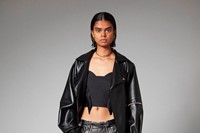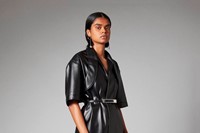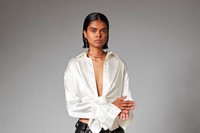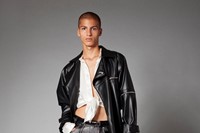As the fashion industry feels out its future, GmbH – the Berlin-based label founded by Serhat Isik and Benjamin Alexander Huseby – is already setting a blueprint of how a brand should be in 2020.
Built on Berlin’s dancefloors – where Isik and Huseby met – GmbH was forged out of a desire to use fashion as a means to start conversations about race and beauty, and to highlight the experiences of marginalised communities. Both Isik and Huseby are children of immigrants – Isik is of Turkish-German descent, Huseby Pakistani-Norwegian – and their collections riff on uniforms and armour, shot through with the sexual frisson of their home city’s queer party scene.
Community is at the heart of their project: most of those who work in the GmbH studio are also descendants of immigrants, so too their friends and collaborators. Their shows – which now take place at Paris Fashion Week – feature near-universally non-white models, likely positively skewing the statistics for some of their contemporaries’ more paltry attempts at runway diversity. Their past campaigns have celebrated second-generation European immigrants (“We, the children, are at once European, but also told we do not truly belong,” they told Dazed at the time), or their own close-knit circle in Berlin, including Honey Dijon and Fatima Al Qadiri, the latter campaign made to protest the city’s rising rents and unregulated real estate market.
More recently, they have become guiding voices in Germany’s Black Lives Matter movement and anti-fascist protests in the Berlin, calling particularly for changes within the fashion industry: “Whether you are Black, brown or of other ethnic minorities you are rarely hired into positions of power,” wrote Isik in one Instagram post. “The sad truth is that in fashion, even access to education and learning is already a great hurdle for most POC ... GmbH is committed to further address, encourage [and] support causes through all our channels to inflict change.”
Isik and Huseby’s Spring 2021 collection comes in the wake of this growing conversation, presented in three parts which culminated at Paris Fashion Week Men’s first digital edition on Saturday evening. Titled Rituals of Resistance, it began with a short film, Guest on Earth, directed by Francisco Sendino. Starring Dijon and dancer MJ Harper, among others, it explored the everyday acts of resistance Isik, Huseby and their friends go through each day in their neighbourhood in Berlin. (When the film was released, the brand noted that neo-nazis had attacked a Syrian family business in the same Kiez neighbourhood one night during filming.)
“It really just came about as we tried to explain the everyday mundane actions of people in our neighbourhood,” the duo tell AnOther of the origins of the project. “It’s about how the simple act of going on with life, and not succumbing to the darkness, is an act of resistance. It is a form of spiritual resistance.”
The second part, screened as part of the official Paris Fashion Week schedule, was an existing video work by the Norwegian artist Lars Laumann. Titled Season of Migration to the North (2015), it tells the story of Eddie Esmail, a young, gay Sudanese asylum seeker, through grainy VHS footage of a runway show in Khartoum he had helped organise and where he – and several of his contemporaries – would be arrested by authorities (their targets were “the boys who they thought looked gay” and girls who looked “immoral”). A powerful first-person voiceover by Esmail, which tells the story of his arrest and subsequent journey to Oslo, juxtaposes the almost-mundane footage; Esmail also describes subsequent ostracisation as a result of both homophobia and Islamophobia once in Norway.
“Benjamin and Lars are very old friends who have collaborated on films before,” explains Isik of how the idea to screen the film first came about. “They made a film in 2009 together about the death of Nico in Ibiza, and also collaborated on an exhibition while they were both in art college in Oslo. We saw Season when it was first screened as an installation in a museum in Oslo.” What struck them about it was the deep sense of feeling the film captures: “As with all Lars’ work there is a strong sense of empathy for the people he portrays. Season is essentially a portrait of Eddie. We actually have been wanting to show this film in the context of GmbH ever since we saw it. The film touches us on so many levels, but it’s of course the intersection of fashion, queerness, politics and migration that resonates with us in a particular way.”
The pair say it is not lost on them that the fashion show in the film looks at times as if it could be a GmbH show – “we wanted to play with this slight confusion: is this real, is it a GmbH show?” they say – but if it influenced the way they put together the Spring 2021 collection, which was revealed in a series of lookbook images at the same time as the screening, it was only “subconsciously”. Instead, they chose the film to reflect their own experiences of homophobia and racism, particularly within the gay community, something they say they can “both relate to personally”. They hope that people will take away from the film “that fashion, when done right, can be an important and transformative field”.
The collection itself began during the coronavirus lockdown in Berlin. “The limitations we had were mostly practical; time and resources,” they say of the experience, which included both Isik and Huseby contracting Covid-19. “But these limitations gave us a focus, and really made clear for us what GmbH is, and what the GmbH wardrobe is.”
Titled ‘Spring’ rather than Spring/Summer – “to indicate both a sense of abruption of time, but also a new beginning” – the pragmatic collection began with them attempting to create a small commercial collection with what they had in the studio after mills and factories had closed down (a process Isik and Huseby are not unfamiliar with, having worked with deadstock in previous seasons, and placed sustainability at the heart of the way they work long before larger brands followed suit). The resulting collection transcended these apparent setbacks for one of their most compelling outings yet, reiterating the house’s signatures – slick vegan leather pants, double flies, harness detailing, and a fixation with uniforms, fetishes and archetypes – with newfound details, like a gorgeous panelled jacket with topstitched seams. The duo call the collection “unashamedly un-gendered”, but playing with “performed identities such as butch and femme, no matter how you identify”.
At the top of the press release which accompanied Rituals of Resistance, they posed a question: “When people are fighting for their lives, does fashion even matter?” It is an apt statement for our current moment, when the usual conversations we have about fashion within our industry suddenly seem woefully unimportant. But the truth is the fashion industry as we now know it is going nowhere fast – in fact, recent days have suggested that the upcoming round of shows in September will look little different to how they did prior to the outbreak of the pandemic in February, with many brands seemingly determined to get back to business as usual.
Which is why voices of dissent – like Isik and Huseby – remain crucial. The duo say that this latest project is an experiment in whether fashion can become a “progressive force”, but the brand they have created is already proof enough of that; GmbH revels in the possibilities of what a fashion label can be. They always knew what it was like to live in a world where the odds are stacked against you because of who you are or where you come from; where even walking down a Berlin street can feel like a high-wire act; to live among a creative community where lockdowns can mean a loss of livelihood, with nothing to fall back on. GmbH is built on these feelings. With them, they have set a powerful example of what a brand can and should look like in 2020. The question is, will the rest of the industry follow their lead?






